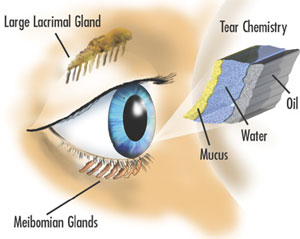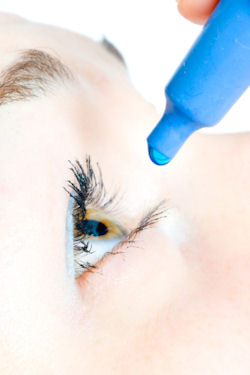| |
Dry eye
 The eye depends on the flow of tears to provide constant moisture and lubrication to maintain clear vision and comfort. Tears are a combination of water, oils, antibodies and special proteins, which are secreted by glands located around the eye. Tears not only wash away dust from the eyes, but also soothe the eyes, provide oxygen and nutrients to the cornea, as well as help defend against eye infections by removing harmful microorganisms that can colonize the eyes. When there is an imbalance in this tear system, a person may experience a gritty sensation, a feeling of a foreign body or sand in the eye, redness, blurred vision, itching, pain, and sensitivity to light. The eye depends on the flow of tears to provide constant moisture and lubrication to maintain clear vision and comfort. Tears are a combination of water, oils, antibodies and special proteins, which are secreted by glands located around the eye. Tears not only wash away dust from the eyes, but also soothe the eyes, provide oxygen and nutrients to the cornea, as well as help defend against eye infections by removing harmful microorganisms that can colonize the eyes. When there is an imbalance in this tear system, a person may experience a gritty sensation, a feeling of a foreign body or sand in the eye, redness, blurred vision, itching, pain, and sensitivity to light.
At times, a patient with a dry eye will have copious tears running down the cheeks. This happens when the eye isn't getting enough moisture and sends a distress signal through the nervous system for more lubrication. In response, it is flooded with an excess of tears to try to compensate for the underlying dryness. However, these tears are mostly water and do not have the lubricating qualities or the composition of normal tears. They will wash debris away, but they will not coat the eye surface properly.

In addition to an imbalance in the tear-flow system of the eye, it can be brought about by other causes that dry out the tear film excessively. These are certain climate conditions such as arid and windy weather, dusty environments and noxious fumes like cigarette smoke, dry draft from air conditioning or a heater, suppression of a blink reflex while working on a computer or watching TV. Other common causes of dry eyes are the natural aging process, especially menopause; side effects of some medications such as antihistamines, blood pressure, and birth control pills; diseases that affect the ability to make tears, such as Sjogren's syndrome, rheumatoid arthritis, and other autoimmune conditions; structural problems with the eye lids that don't allow them to close properly. Yet another important reason for dry eye is contact lens wear, since the lenses tend to wick away natural lubricants and cause the tears evaporate more rapidly.
Though dry eyes cannot be cured, there are a number of steps that can be taken to treat them. The use of artificial teardrops is the primary treatment for dry eye. No one drop works for everyone, so you might have to experiment to find the drop that works for you. If you have chronic dry eye, it is important to use the drops even when your eyes feel fine to stave off tear loss and keep them lubricated. If your eyes dry out while you sleep, you can use a thicker lubricant, such as a gel or an ointment, at night.
Sometimes it is necessary to close the ducts that drain tears out of the eye with a silicone plug that painlessly inserted into the drain opening (punctum) on the lower eyelid in order to retain an adequate tear level in the eye. This is called punctal occlusion. The plugs can be easily removed at a later time if needed. Many patients find that the plugs improve comfort, alleviate other symptoms, and reduce the need for artificial tears.

In 2002, the FDA approved the prescription eye drop Restasis for the treatment of chronic dry eye. It is currently the only prescription eye drop that helps your eyes increase their own tear production with continued use.
Other medications, including topical steroids and antibiotics, may also be beneficial in some cases.
If needed, the ducts that drain tears into the nose can be permanently closed to allow more tears to remain around the eye.
Please discuss treatment options with your ophthalmologist. |
|